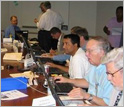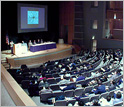 |
||||
|
|
||||
|
NSF's task of identifying and funding work at the frontiers of science and engineering is not a "top-down" process. NSF operates from the "bottom up," keeping close track of research around the United States and the world, maintaining constant contact with the research community to identify ever-moving horizons of inquiry, monitoring which areas are most likely to result in spectacular progress and choosing the most promising people to conduct the research. Awardees are chosen from those who send us proposals asking for a specific amount of support for a specific project. This process begins with workshops and conferences to discuss the progress of science and engineering and what the United States needs to accomplish in each field. Next, the agency publishes a notice about a funding opportunity (usually called a "solicitation"), which invites researchers to submit proposals describing their ideas on how to meet a particular need. At any time, scientists and engineers are also welcome to send in unsolicited proposals for research and education projects, in any existing or emerging field. At present, NSF receives more than 42,000 proposals per year. Nearly every proposal, whether solicited or unsolicited, receives the same rigorous and objective treatment. It is evaluated by a panel of independent reviewers consisting of scientists, engineers and educators, who do not work at NSF or for the institution that employs the proposing researchers. NSF selects the reviewers from among the national pool of experts in each field and their evaluations are confidential. On average, about 50,000 experts now give their time to serve on review panels each year. The panel's job is to decide which projects are the very highest priorities. This competitive process, called "merit review", ensures that many voices are heard and that only the best projects make it to the funding stage. An enormous amount of research, deliberation, thought and discussion goes into the final recommendations of the independent reviewers. |
|
||||||||
| Web Policies and Important Links | | | Privacy | | | FOIA | | | Help | | | Contact NSF | | | Contact Webmaster | | | SiteMap |
|
The National Science Foundation, 4201 Wilson Boulevard, Arlington, Virginia 22230, USA Tel: (703) 292-5111 , FIRS: (800) 877-8339 | TDD: (800) 281-8749 |
|
|
Last Updated: Jul 10, 2008 |
|||



